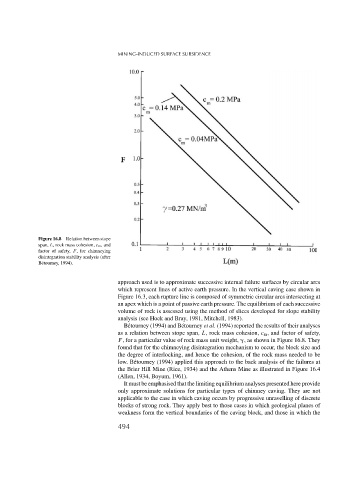Page 512 - Rock Mechanics For Underground Mining
P. 512
MINING-INDUCED SURFACE SUBSIDENCE
Figure 16.8 Relation between stope
span, L, rock mass cohesion, c m , and
factor of safety, F, for chimneying
disintegration stability analysis (after
B´etourney, 1994).
approach used is to approximate successive internal failure surfaces by circular arcs
which represent lines of active earth pressure. In the vertical caving case shown in
Figure 16.3, each rupture line is composed of symmetric circular arcs intersecting at
an apex which is a point of passive earth pressure. The equilibrium of each successive
volume of rock is assessed using the method of slices developed for slope stability
analysis (see Hoek and Bray, 1981, Mitchell, 1983).
B´etourney (1994) and B´etourney et al. (1994) reported the results of their analyses
as a relation between stope span, L, rock mass cohesion, c m , and factor of safety,
F, for a particular value of rock mass unit weight, , as shown in Figure 16.8. They
found that for the chimneying disintegration mechanism to occur, the block size and
the degree of interlocking, and hence the cohesion, of the rock mass needed to be
low. B´etourney (1994) applied this approach to the back analysis of the failures at
the Brier Hill Mine (Rice, 1934) and the Athens Mine as illustrated in Figure 16.4
(Allen, 1934, Boyum, 1961).
It must be emphasised that the limiting equilibrium analyses presented here provide
only approximate solutions for particular types of chimney caving. They are not
applicable to the case in which caving occurs by progressive unravelling of discrete
blocks of strong rock. They apply best to those cases in which geological planes of
weakness form the vertical boundaries of the caving block, and those in which the
494

